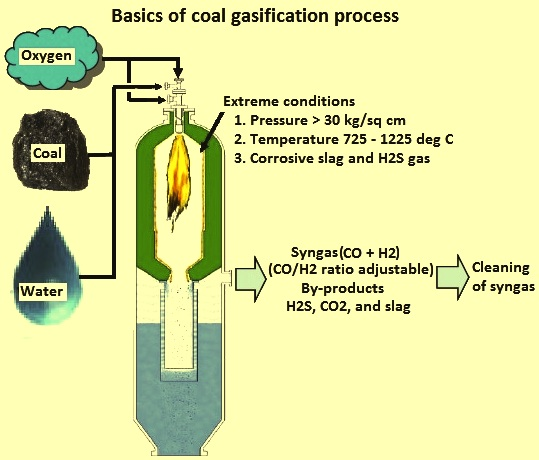Biodiversity & Environment
Coal Gasification
- 28 May 2022
- 4 min read
For Prelims: Coal Gasification, Syngas, Hydrogen Economy
For Mains: Coal Gasification, Hydrogen Economy, Concerns Associated with Coal Gasification Plants
Why in News?
The Ministry of Coal has prepared a National Mission document to achieve 100 MT (Million Tonnes) Coal Gasification by 2030.
What is Coal Gasification?
- Process: Coal gasification is a process in which coal is partially oxidised with air, oxygen, steam or carbon dioxide to form a fuel gas.
- This gas is then used instead of piped natural gas, methane and others for deriving energy.
- In-situ gasification of coal – or Underground Coal Gasification (UCG) – is the technique of converting coal into gas while it is still in the seam and then extracting it through wells.
- Production of Syngas: It produces Syngas which is a mixture consisting primarily of methane (CH4), carbon monoxide (CO), hydrogen (H2), carbon dioxide (CO2) and water vapour (H2O).
- Syngas can be used to produce a wide range of fertilizers, fuels, solvent and synthetic materials.
What is the Significance of Coal Gasification?
- Steel companies typically use coking coal in their manufacturing process. Most of the coking coal is imported and is expensive. To cut costs, plants can use syngas, which comes from coal gasification plants in the place of coking coal.
- It is primarily used for electricity generation, to produce chemical feedstocks.
- The hydrogen obtained from coal gasification can be used for various purposes such as making ammonia, powering a Hydrogen Economy.
- India’s hydrogen demand is likely to increase to 11.7 million tonnes by 2030 from 6.7 million tonnes per year as of now. Refineries and fertiliser plants are the largest consumers of hydrogen now, which is being produced from natural gas. It can be produced through coal in the processes during coal gasification.
What are the Concerns associated with Coal Gasification Plants?
- Environmental Perspective: Coal gasification actually produces more carbon dioxide than a conventional coal-powered thermal power plant.
- According to CSE estimates, one unit of electricity generated by burning gasified coal generates 2.5 times more carbon dioxide than what would result when burning the coal directly.
- Efficiency Perspective: The syngas process converts a relatively high-quality energy source (coal) to a lower quality state (gas) and consumes a lot of energy in doing so.
- Thus, the efficiency of conversion is also low.
What is the Hydrogen Economy?
- It is an economy that relies on hydrogen as the commercial fuel that would deliver a substantial fraction of a nation’s energy and services.
- Hydrogen is a zero-carbon fuel and is considered an alternative to fuel and a key source of clean energy.
- It can be produced from renewable sources of energy such as solar and wind.
- It is an envisioned future where hydrogen is used as fuel for vehicles, energy storage and long-distance transport of energy.
- The different pathways to use hydrogen economy includes hydrogen production, storage, transport and utilization.
- In 1970, the term 'Hydrogen Economy' was coined by John Bockris.
- He mentioned that a hydrogen economy can replace the current hydrocarbon-based economy, leading to a cleaner environment.
Way Forward
- Companies need to adopt new technologies and build digital infrastructure to support the current and future requirements.
- There is a need to ensure optimal use of technology in the sector.





